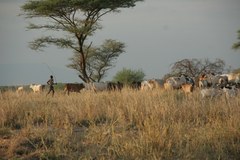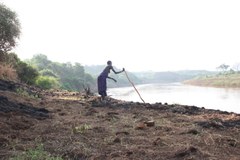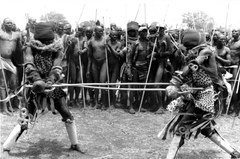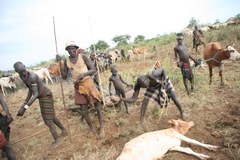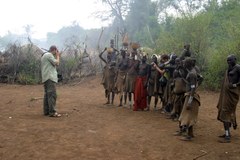Introducing the Mursi: Overview
The Mursi (Mun, sg. Muni) live in the Lower Omo Valley of southwestern Ethiopia and number less than 10,000. Their territory of around 2,000 km2 lies in the South Omo Zone of the Southern Nations, Nationalities and Peoples' Regional State (SNNPRS), roughly between the Rivers Omo (Warr) and Mago (Mako). They speak a Surmic language belonging to the Nilo-Saharan language family. They share a common language, and frequently intermarry, with the Chai, who live west of the Omo and south of Maji. See Maps 2 & 3.
The Mursi see themselves as the product of a series of migrations, all of which were part of a continuing effort to find and occupy a "cool place" (bha lalini), a place with riverside forest for cultivation and well watered grassland for cattle herding. Cattle continue to make a vital contribution to their diet. But although often described as 'nomads' by government officials, they lead a relatively settled life and depend heavily upon cultivation. During the dry season they live mainly along the banks of the Omo. When the rains come they return to the grasslands, east of the river, to live close to their cattle and enjoy the fresh milk.
Life for the Mursi is often arduous and sometimes dangerous. But they have learnt to live well and there is much time for relaxation, chatting, music and gossip. They have a rich oral tradition through which they preserve and transmit their history, philosophical knowledge and moral stories. They have a keen aesthetic life that centres on their awareness of colour, cattle and body painting. Two distinctive features of their society by which they have become known to outsiders, are ceremonial duelling (sagine) and the large pottery discs or 'plates' (debhinya) which are worn by women in their lower lips.
Dueling is a form of martial art, in which teams of men from different local divisions of the population (bhuranyoga) fight each other with two-metre wooden poles (dongen) in short but fierce bouts. The lip-plate is an expression of female social adulthood. A girl will have her lip pierced by her mother, or another woman of her local community, when she reaches the age of around fifteen. Adult men belong to named 'age sets' and pass through a series of 'age grades', while married women take their age status from their husbands.
Leadership is exercised by individual elders who have achieved a position of influence in the local community through their oratorical and debating skills and through their knowledge of precedent and tradition. The only formally defined leadership role is that of priest (komoru). Each major local division of the population (bhuran) has its priest, who embodies the well-being of the local community and acts as a means of communication between the community and God (tumwi), especially when it is threatened by such events as drought, crop pests and disease.
Religion and healing are very much interconnected for the Mursi. A knowledge of illness and of the divine emerges from people's experiences of the natural and social world. Priests provide the context for a healthy community and it is the priest as well as members of other lesser ritual families (e'wu) who are sought out to treat epidemics, drought, and crop pests. The Mursi also have a healing tradition based around the powers of women healers (ngerrêa, sg. ngerrê).
Over the past few decades, the Mursi search for a "cool place" has come up against the much more powerful 'place making' activities of the Ethiopian state. Mursiland was first incorporated into the Ethiopian state at the end of the nineteenth century, when the Abyssinian king Menelik II expanded his kingdom southwards and established Ethiopia's modern borders with Kenya, Sudan and Somalia. But it was not until after World War II that the centre began to establish the kind of political control over the periphery that allows us to speak realistically of state incorporation.
Perhaps the most significant early step in this direction came in the 1960s with the establishment of the Omo National Park. Improved transportation has also drawn the Mursi further into the market economy, where trade in cattle and increasing numbers of tourists provide money which the Mursi use to buy cloth, medicine, coffee, spices and agricultural tools. Today, the process of state-building in the lower Omo appears to have reached a new level of intensity, with the construction of a huge hydroelectric dam in its middle basin. This will eliminate the annual flood upon which the downstream population has always depended for cultivation and pastoralism and make possible large-scale commercial irrigation schemes.' These will require the forced displacement and resettlement of thousands of people and irrevocably transform their environment and way life.


